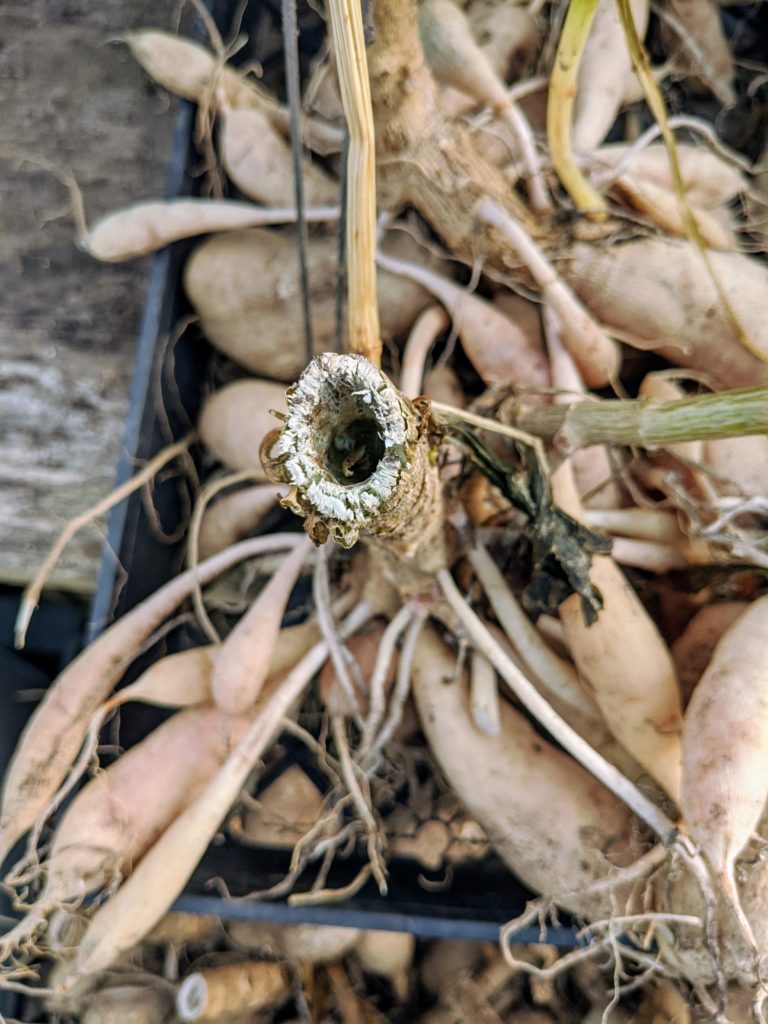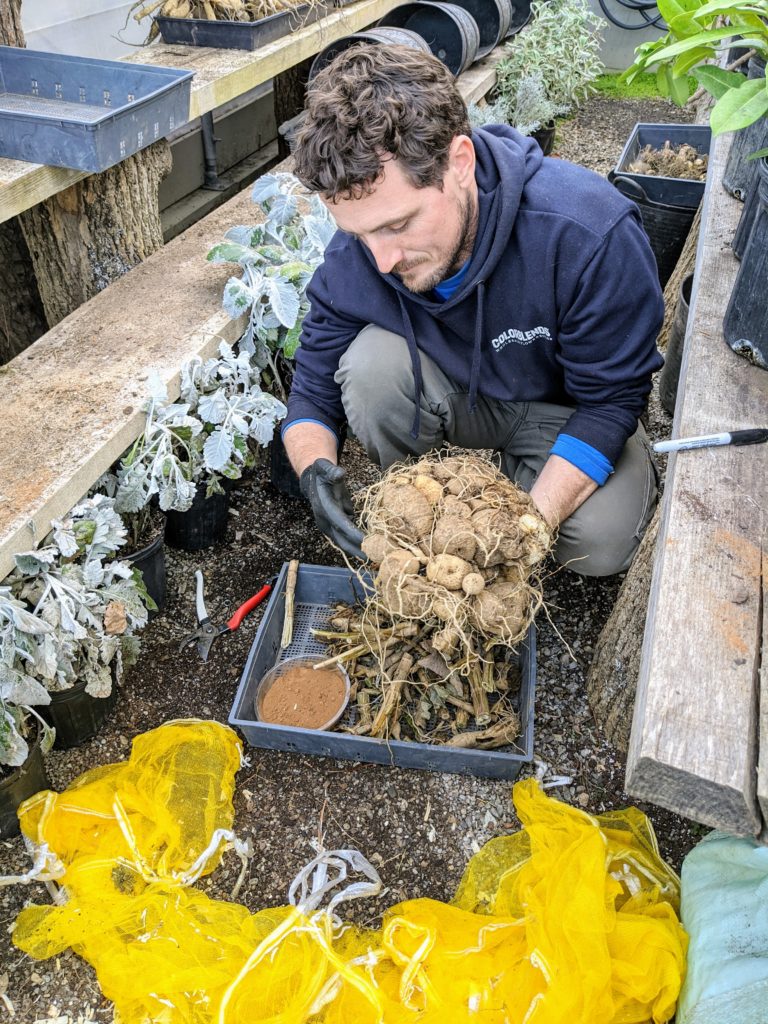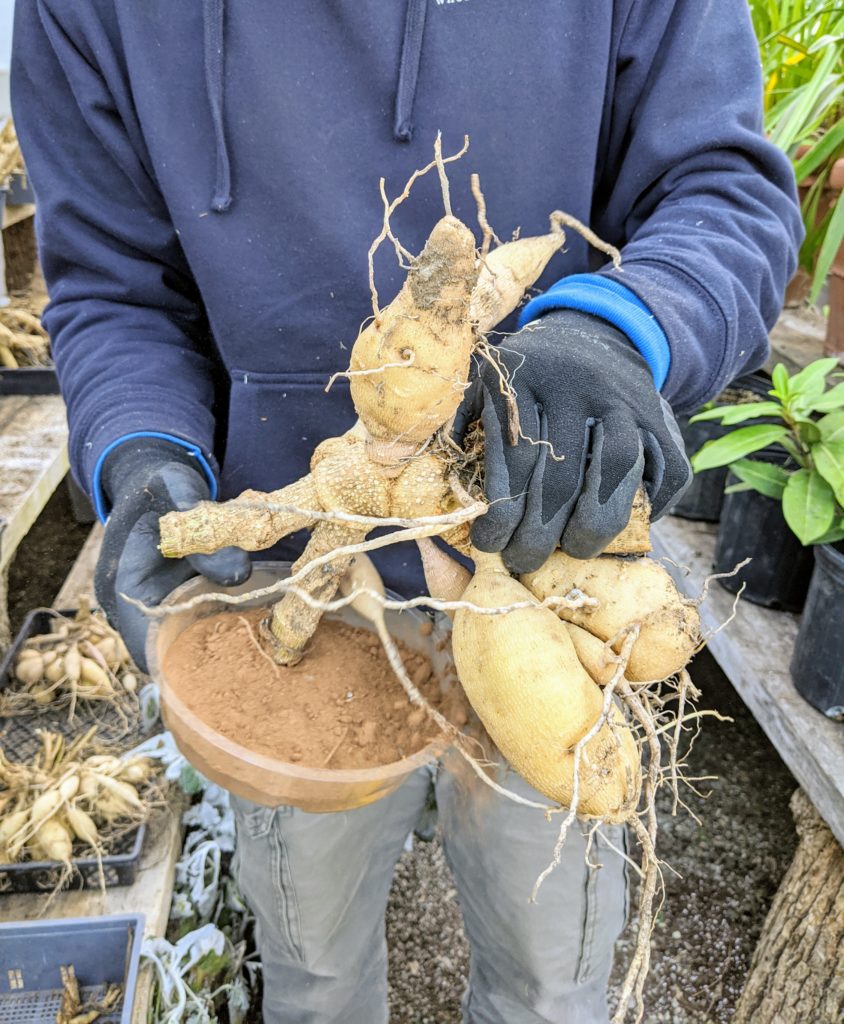Why Proper Storage is Crucial for Dahlia Tubers
As the winter months approach, it’s essential to take the necessary steps to ensure the survival of dahlia tubers. Proper storage is critical to maintaining the health and viability of these delicate underground structures. If not stored correctly, dahlia tubers can succumb to rot, decay, and pest infestation, rendering them useless for future growth.
The primary goal of storing dahlia tubers for winter is to provide a cool, dry environment that slows down their metabolic processes. This helps to conserve energy and prevent damage from extreme temperatures and moisture fluctuations. By storing dahlia tubers correctly, gardeners can enjoy a bountiful harvest of vibrant blooms in the spring.
When dahlia tubers are not stored properly, they can become vulnerable to disease and pests. Fungal infections, such as botrytis and powdery mildew, can take hold in damp environments, while insects like slugs and snails can feed on the tubers’ tender flesh. Moreover, if the tubers are exposed to freezing temperatures, they can suffer irreparable damage, making it impossible for them to regrow in the spring.
To avoid these pitfalls, it’s crucial to store dahlia tubers in a way that maintains their health and integrity. This involves carefully preparing the tubers for storage, selecting the right storage method, and monitoring their condition throughout the winter months. By following these steps, gardeners can ensure that their dahlia tubers remain healthy and viable, ready to burst forth with new growth when the weather warms up.
In the next section, we’ll explore the process of preparing dahlia tubers for winter storage, including cutting back foliage, digging and cleaning the tubers, and allowing them to dry. By understanding these critical steps, gardeners can set themselves up for success and enjoy a thriving dahlia crop in the spring.
Preparing Dahlia Tubers for Winter Storage
Before storing dahlia tubers for winter, it’s essential to prepare them properly to ensure their survival and healthy regrowth in the spring. The preparation process involves several steps, including cutting back foliage, digging and cleaning the tubers, and allowing them to dry.
Cut back the dahlia foliage to within a few inches of the ground, using a pair of clean, sharp pruning shears. This will help to prevent moisture from entering the tubers and reduce the risk of rot and decay. Next, carefully dig up the dahlia tubers, taking care not to damage them with the shovel or fork.
Once the tubers are dug up, gently remove any excess soil and debris, using a soft-bristled brush or a cloth. This will help to prevent any dirt or debris from entering the storage container and causing damage to the tubers. Rinse the tubers gently with water to remove any remaining soil or debris.
After cleaning the tubers, allow them to dry for a few hours to a few days, depending on the humidity and temperature. This will help to prevent moisture from accumulating on the tubers and reduce the risk of rot and decay. You can speed up the drying process by placing the tubers in a warm, dry location, such as a greenhouse or a sunny windowsill.
It’s also essential to inspect the tubers for any signs of damage or disease, such as cracks, soft spots, or fungal growth. Remove any damaged or diseased tubers, as they can infect the healthy tubers during storage.
By following these steps, you can ensure that your dahlia tubers are properly prepared for winter storage, setting them up for healthy regrowth in the spring. In the next section, we’ll discuss the different storage methods for dahlia tubers, including storing in a cool, dark place, using a breathable container or bag, and burying in a protected area.
Choosing the Right Storage Method for Your Dahlia Tubers
When it comes to storing dahlia tubers for winter, there are several methods to choose from, each with its own pros and cons. The right storage method for you will depend on your specific climate, available space, and personal preferences. Here, we’ll discuss three common storage methods for dahlia tubers: storing in a cool, dark place, using a breathable container or bag, and burying in a protected area.
Storing dahlia tubers in a cool, dark place is a popular method, as it provides a consistent temperature and humidity level. This can be achieved by storing the tubers in a basement, garage, or shed. However, it’s essential to ensure that the area is well-ventilated and free from pests and diseases. A temperature range of 40-50°F (4-10°C) is ideal for storing dahlia tubers.
Using a breathable container or bag is another effective method for storing dahlia tubers. This can be a paper bag, burlap sack, or a ventilated plastic container. The key is to provide adequate airflow and prevent moisture from accumulating. This method is ideal for gardeners who live in areas with high humidity or limited storage space.
Burying dahlia tubers in a protected area is a more traditional method, often used by gardeners who live in areas with mild winters. This involves digging a trench or hole in a protected area, such as a cold frame or greenhouse, and burying the tubers in a layer of sand or peat moss. This method provides excellent protection from extreme temperatures and moisture fluctuations.
Regardless of the storage method chosen, it’s essential to ensure that the dahlia tubers are stored in a way that prevents moisture from accumulating and promotes healthy growth. By choosing the right storage method for your dahlia tubers, you can ensure their survival and healthy regrowth in the spring.
In the next section, we’ll provide a step-by-step guide on how to store dahlia tubers in a container or bag, including the materials needed and tips for maintaining the right conditions.
How to Store Dahlia Tubers in a Container or Bag
Storing dahlia tubers in a container or bag is a popular method for winterizing these delicate underground structures. This method provides excellent protection from extreme temperatures, moisture fluctuations, and pests. Here’s a step-by-step guide on how to store dahlia tubers in a container or bag:
Materials needed:
- A breathable container or bag, such as a paper bag, burlap sack, or ventilated plastic container
- Dry peat moss or vermiculite
- A layer of newspaper or paper towels
Instructions:
1. Fill the container or bag with a layer of dry peat moss or vermiculite. This will help to absorb any excess moisture and maintain a consistent humidity level.
2. Place the dahlia tubers in the container or bag, making sure they are not touching each other or the sides of the container.
3. Add a layer of newspaper or paper towels on top of the tubers. This will help to maintain humidity and prevent moisture from accumulating.
4. Seal the container or bag, but make sure it is not airtight. You want to allow for some airflow to prevent the buildup of moisture.
5. Store the container or bag in a cool, dark place, such as a basement or garage. The ideal temperature for storing dahlia tubers is between 40-50°F (4-10°C).
Tips for maintaining the right conditions:
Make sure the container or bag is kept away from direct sunlight and heat sources.
Check the tubers regularly to ensure they are not rotting or developing mold.
Keep the container or bag slightly ajar to allow for airflow and prevent moisture buildup.
By following these steps and tips, you can ensure that your dahlia tubers are stored safely and healthily in a container or bag, ready to be planted in the spring.
Storing Dahlia Tubers in a Protected Outdoor Area
Storing dahlia tubers in a protected outdoor area is a great option for gardeners who live in areas with mild winters or have limited indoor storage space. This method involves burying the tubers in a trench or cold frame, where they can be protected from extreme temperatures and moisture fluctuations.
Benefits of storing dahlia tubers in a protected outdoor area:
- Space-saving: This method is ideal for gardeners who have limited indoor storage space or want to keep their tubers separate from other plants.
- Natural temperature regulation: The earth provides natural insulation, keeping the tubers at a consistent temperature and preventing extreme temperature fluctuations.
- Moisture control: The soil helps to regulate moisture levels, preventing the tubers from becoming too dry or too wet.
Challenges of storing dahlia tubers in a protected outdoor area:
- Weather conditions: Extreme weather conditions, such as heavy rainfall or prolonged drought, can affect the tubers’ health and survival.
- Pests and diseases: Outdoor storage can make the tubers more susceptible to pests and diseases, such as rodents, slugs, and fungal infections.
- Accessibility: Depending on the location and depth of the trench or cold frame, it may be difficult to access the tubers during the winter months.
To store dahlia tubers in a protected outdoor area, follow these steps:
1. Choose a location with good drainage and protection from extreme weather conditions.
2. Dig a trench or cold frame that is deep enough to accommodate the tubers and provide adequate insulation.
3. Line the trench or cold frame with a layer of sand or peat moss to help regulate moisture levels.
4. Place the dahlia tubers in the trench or cold frame, making sure they are not touching each other or the sides of the container.
5. Cover the tubers with a layer of soil and mulch to provide additional insulation and protection.
By following these steps and considering the benefits and challenges of storing dahlia tubers in a protected outdoor area, you can ensure the health and survival of your tubers during the winter months.
Tips for Maintaining Healthy Dahlia Tubers During Winter Storage
Proper care and maintenance are crucial for keeping dahlia tubers healthy during winter storage. Here are some tips to help you maintain the health and viability of your tubers:
Monitor for pests and diseases:
- Regularly inspect your tubers for signs of pests or diseases, such as mold, mildew, or insect infestations.
- Remove any affected tubers to prevent the spread of disease.
Maintain the right temperature and humidity levels:
- Store your tubers in a location with a consistent temperature between 40-50°F (4-10°C).
- Keep the humidity level around 50-60% to prevent moisture from accumulating.
Provide adequate ventilation:
- Make sure your storage container or bag has adequate ventilation to prevent moisture buildup.
- Check on your tubers regularly to ensure they are not developing mold or mildew.
Avoid over-handling:
- Minimize handling of your tubers to prevent damage and stress.
- Handle tubers gently and carefully to avoid bruising or breaking.
Keep tubers away from light:
- Store your tubers in a dark location to prevent light from stimulating growth.
- Use a breathable container or bag to allow for airflow and prevent moisture buildup.
By following these tips, you can help maintain the health and viability of your dahlia tubers during winter storage. Remember to check on your tubers regularly and take action if you notice any signs of pests, diseases, or damage.
Common Mistakes to Avoid When Storing Dahlia Tubers
When storing dahlia tubers for winter, it’s essential to avoid common mistakes that can lead to rot, decay, and pest infestation. Here are some mistakes to avoid:
Storing in a warm or humid location:
- Avoid storing dahlia tubers in a warm or humid location, such as a basement or attic, as this can lead to rot and decay.
- Instead, store them in a cool, dark place with a consistent temperature between 40-50°F (4-10°C).
Not providing adequate ventilation:
- Make sure your storage container or bag has adequate ventilation to prevent moisture buildup.
- Check on your tubers regularly to ensure they are not developing mold or mildew.
Storing tubers too close together:
- Avoid storing dahlia tubers too close together, as this can lead to moisture accumulation and rot.
- Instead, store them in a single layer, making sure they are not touching each other or the sides of the container.
Not monitoring for pests and diseases:
- Regularly inspect your tubers for signs of pests or diseases, such as mold, mildew, or insect infestations.
- Remove any affected tubers to prevent the spread of disease.
By avoiding these common mistakes, you can help ensure the health and viability of your dahlia tubers during winter storage. Remember to check on your tubers regularly and take action if you notice any signs of pests, diseases, or damage.
Getting Your Dahlia Tubers Ready for Spring
As the weather begins to warm up in the spring, it’s time to start preparing your dahlia tubers for planting. Here’s a step-by-step guide on how to get your dahlia tubers ready for spring:
Potting up indoors:
- About 4-6 weeks before the last frost date, pot up your dahlia tubers in a container filled with a well-draining potting mix.
- Water the tubers thoroughly and provide them with bright, indirect light.
- Keep the soil consistently moist but not waterlogged.
Hardening off:
- About 1-2 weeks before transplanting outside, start hardening off your dahlia tubers by gradually exposing them to outdoor conditions.
- Start by moving the pots to a shaded area outdoors for a few hours a day, then gradually increase the duration and intensity of the sunlight.
Transplanting outside:
- Once the danger of frost has passed, transplant your dahlia tubers outside into a location with full sun and well-draining soil.
- Space the tubers 12-18 inches apart and water them thoroughly after transplanting.
By following these steps, you can help ensure that your dahlia tubers are healthy and ready to thrive in the spring. Remember to monitor their progress and take action if you notice any signs of pests, diseases, or damage.



:max_bytes(150000):strip_icc()/dahlia-tubers-in-Ziploc-56a583c83df78cf77288adb6.jpg)





